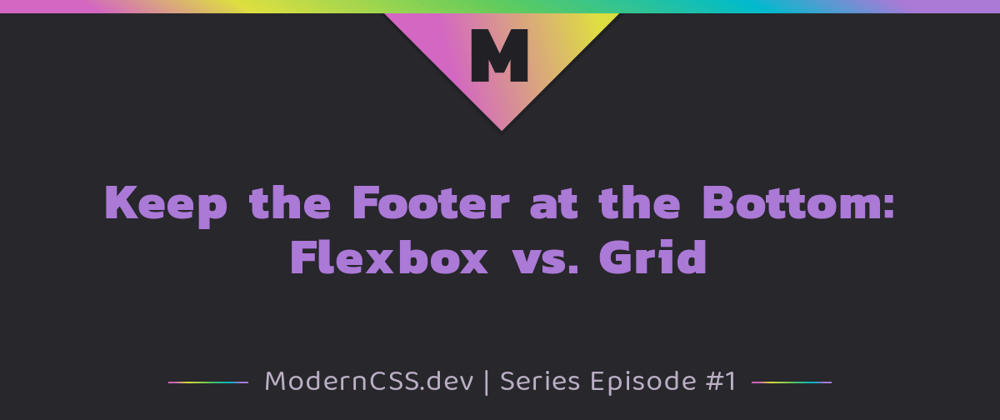This is the first post in a series examining modern CSS solutions to problems I've been solving over the last 13+ years of being a frontend developer. Visit ModernCSS.dev to view the whole series and additional resources.
For many years, I constantly referred to this article by Matthew James Taylor for a method to keep a webpage footer at the bottom of the page regardless of the main content length. This method relied on setting an explicit footer height, which is not scalable but a very good solution BF (Before Flexbox).
If you mostly deal with SPA development, you may be confused about why this problem is still around, but it's still a possibility to find your footer floating up for:
- login pages
- blog/news articles (with no ads...)
- interstitial pages of a flow like confirming actions
- product listing pages
- calendar event details
There are two ways to handle this with modern CSS: flexbox and grid.
Here's the demo, defaulted to the flexbox method. If you open the full Codepen, you can swap the $method variable to grid to view that alternative.
Read on past the demo to learn about each method.
Flexbox Method
This method is accomplished by defining:
body {
min-height: 100vh;
display: flex;
flex-direction: column;
}
footer {
margin-top: auto;
}
// Optional
main {
margin: 0 auto;
// or: align-self: center
max-width: 80ch;
}
How it Works
First, we ensure the body element will stretch to at least the full height of the screen with min-height: 100vh. This will not trigger overflow if content is short (exception: certain mobile browsers) and it will allow content to continue stretching the height as needed.
Setting flex-direction: column keeps the behavior of normal document flow in terms of retaining stacked block-elements (which assumes direct children of body are all indeed block elements).
The advantage of flexbox is in leveraging the margin: auto behavior. This one weird trick will cause the margin to fill any space between the item it is set on and its nearest sibling in the corresponding direction. Setting margin-top: auto effectively pushes the footer to the bottom of the screen.
Gotcha
In the demo, I've added an outline to main to demonstrate that in the flexbox method the main element doesn't fill the height. Which is why we have to use the margin-top: auto trick. This is not likely to matter to you, but if it does, see the grid method which stretches the main to fill the available space.
Grid Method
This method is achieved by setting:
body {
min-height: 100vh;
display: grid;
grid-template-rows: auto 1fr auto;
}
// Optional
main {
margin: 0 auto;
max-width: 80ch;
}
How it Works
We retain the min-height: 100vh for this method, but we then use of grid-template-rows to space things correctly.
This method's weird trick is using the special grid unit fr. The fr means "fraction" and using it requests that the browser computes the available "fraction" of space that is left to distribute to that column or row. In this case, it fills all available space between the header and footer, which also solves the "gotcha" from the flexbox method.
Which is Better?
After seeing grid, you may have a moment of thinking it's clearly superior. However, if you add more elements between the header and footer you need to update your template (or ensure there's always a wrapping element such as a div to not affect any nested semantics/hierarchy).
On the other hand, the flexbox method is usable across various templates with multiple block elements in the midsection - for example, a series of <article> elements instead of a single <main> for an archive page.
So as with all techniques, it depends on the project :) But we can all agree it's amazing to have these modern CSS layout methods!







Top comments (7)
Resourceful posts! Lovin' your series!
Can you tell me how you generate: Marzipan soufflé cotton candy tart sweet bonbon. Macaroon fruitcake pie gummies gummi bears biscuit dragée. Topping icing marshmallow. Soufflé gummies dessert jelly dessert liquorice.
Is ti an Emmet thing? Like Lorem Ipsum?
I use cupcakeipsum.com/
Glad you're enjoying the series!
You have sugar-coated my day!
Thank you
I dunno if you are a coffee person, but I've just seen this as well :
coffeeipsum.com/
Haha, nice!
Thank you Stephanie for this great sires!
For the grid method, you don't have to wrap your content in the
<main>tag instead you can use a negative number to ensure that the footer will always remain as the last row in your template!Ok.